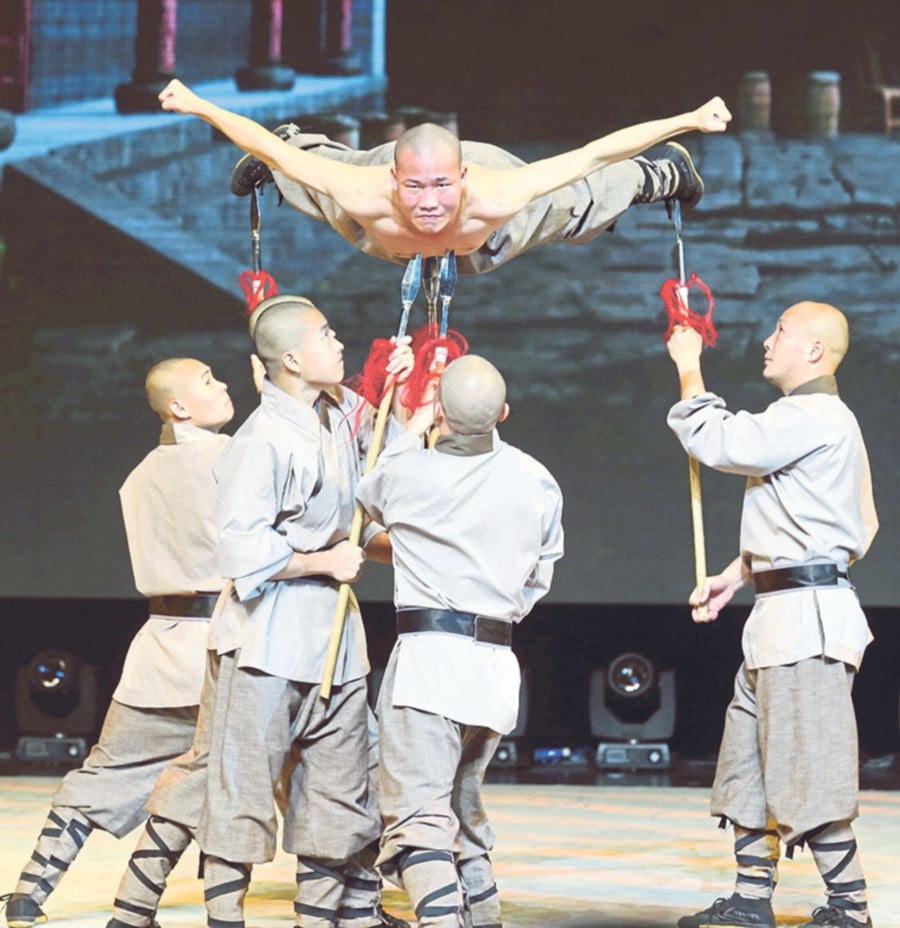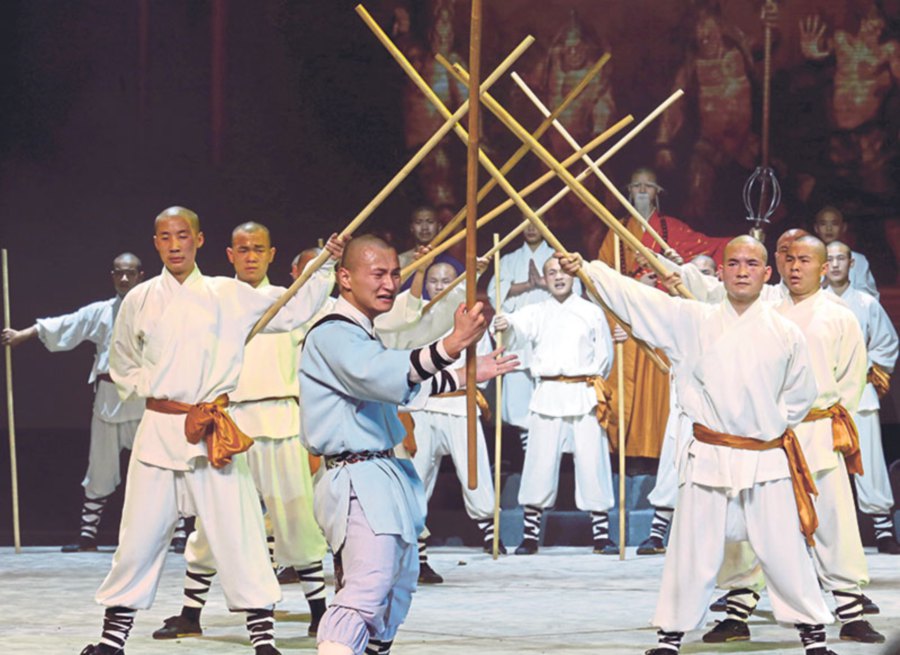NO words are uttered. Men with clean-shaven heads clad in pristine white robes fully utilise every inch of the stage. Armed with shiny broadswords and staffs — one of the four major weapons used in Chinese martial arts and which are known in Chinese folklore as “the grandfather of all weapons” — they move to the rhythm of the haunting music playing in the background.
The digital backdrop provides a complementary ambience en pointe, flawlessly changing from the cool, windy forest to the quiet monastery where Shaolin monks reside, in a story of a boy transforming into a young man, right before the audience’s eyes.
While one may be used to the awe-inspiring character of kung fu master Wong Fei Hung, thanks to the countless movies and productions featuring Jet Li, Donnie Yen and Jackie Chan, this performance offers a rare chance to witness actual heroes who have spent most of their lives learning one of the oldest institutionalised Chinese martial arts.
The Soul Of Shaolin: Hui Gang’s Story theatre show takes us on a painful life journey of young Hui Gang, who grows up in the Shaolin temple after being left behind by his mother who is being pursued by a group of bandits.
An amalgamation of theatrical performance and martial arts, this show is a refreshing departure from the usual dance routines that colour musical performances. The audience is treated to the intricate art of kung fu, mastered through the absolute dedication of the 32-strong crew.

THE STORY UNFOLDS
The show opens with four small groups of young monks from a Shaolin temple performing a masterful dance using long poles, eventually culminating in a stunning formation of human stairs before the spotlight moves on to a sobbing young mother who’s hiding her baby behind a rock as she attempts to escape a group of sword-wielding bandits in black robes.
The dramatic, colourful lighting helps convey the mood perfectly, while the digital backdrop of a thunderstorm lends a dramatic air to the parting scene between a distraught mother and her child. Breaking a piece of jade into two, she leaves one half with her child before running for her life.
Meanwhile, the child Hui Gang, is later found by Na Luo, a Shaolin monk (played by Shi Tai Long, 27, who has been involved in martial arts since the age of 17). He, together with the rest of his comrades, saves the villagers from the savage bandits. With the consent of the elderly abbot Miao Xing, Na Luo raises Hui Gang and becomes his father figure.
This phase is beautifully conveyed in a number of scenes that truly tug at the heartstrings, for example, we see Na Luo lovingly feeding Hui Gang and rocking him to sleep while the latter cries for his mother. It captures the battle-worn warrior’s tender side.
The tale also offers insight into the strict rules that the Shaolin community adheres to. We see how Hui Gang is forced to
fight his way out of the temple as ordered by his abbot in a bid to reunite with his
mother.
At the periphery of the scene, the cast pulls off logic-defying stunts including body contortions that showcase their amazing level of fitness and the punishing training regimen that they’ve undergone to prepare for this show, incorporating the use of various Shaolin weapons, including the spear and whip.
This delightful performance continues as the young Hui Gang, ably portrayed by the young star of the show, 10-year-old Gong Jia Yu, wows the crowd as he does cartwheels. Gong’s flexibility and energetic performance impress the audience, drawing hearty applause.
The Soul Of Shaolin: Hui Gang’s Story is very ambitious through its attempts to project emotions and story without the use of words. Action, expressions, movements as well as well as props, costumes and background music form a universal language that’s able to reach out to a global audience.
The troop also had the advantage of being trained by China’s top kickboxer, Coach Jiao Xiao Wei, said to be the best kickboxer in China, along with three martial arts teachers.
According to musical director Xue Wei Jun, a performance arts lecturer based in Shanghai University, the play, comprising a supple blend of martial and performance arts, was conceived 14 years ago.
“The moves were choreographed to display the different stunts and types of weapons used in Shaolin kung fu. They’re chosen for different scenes to make them appropriate,” explains Xue, adding that the cast changes every year as Hui Gang’s character literally grows up in front of the audience. They require performers from as young as 10 to those in their late 20s to effectively portray the character in the story.
The current cast members who performed at the recent Genting Highlands International showroom included Gong as well as the original child performer, Zhang Bin, who’s now in his 30s.
“Some of the cast members have been training between five and six years while others have undergone more than a decade of training. All hailing from across China, they’re students of the martial arts centre and were selected based on their skills,” adds Xue.
He shares that mentoring is very much part of the whole process as those who used to play the young Hui Gang now coach the newbies who are roped in to take on the role for a new season. This allows for sustainability.
“They have to undergo different stages of the selection process for the show,” he reveals, adding that the show has been nominated for Best Special Theatrical Event (Tony Awards 2009) and Unique Theatrical Experience (Drama Desk Awards, 2009). When it opened at the Marquis Theatre on Broadway in January 2009, all of its seven performances were sold out.
Since its debut in 2009, the globetrotting Shaolin kung fu warriors have held more than 500 performances, travelled to over 10 countries including the US, Australia, Italy, Norway, India, Korea, Turkey, Macau, Hong Kong, Turkey and Indonesia.
The Soul of Shaolin is also billed as China’s key cultural export by China’s Ministry of Culture, Ministry of Commerce, the State Administration of Radio, Film & Television and the General Administration of Press and Publication.
“We’ve won many awards in China. If we bring the show back to the United States, I think we’ll definitely win this time,” says Xue confidently.









